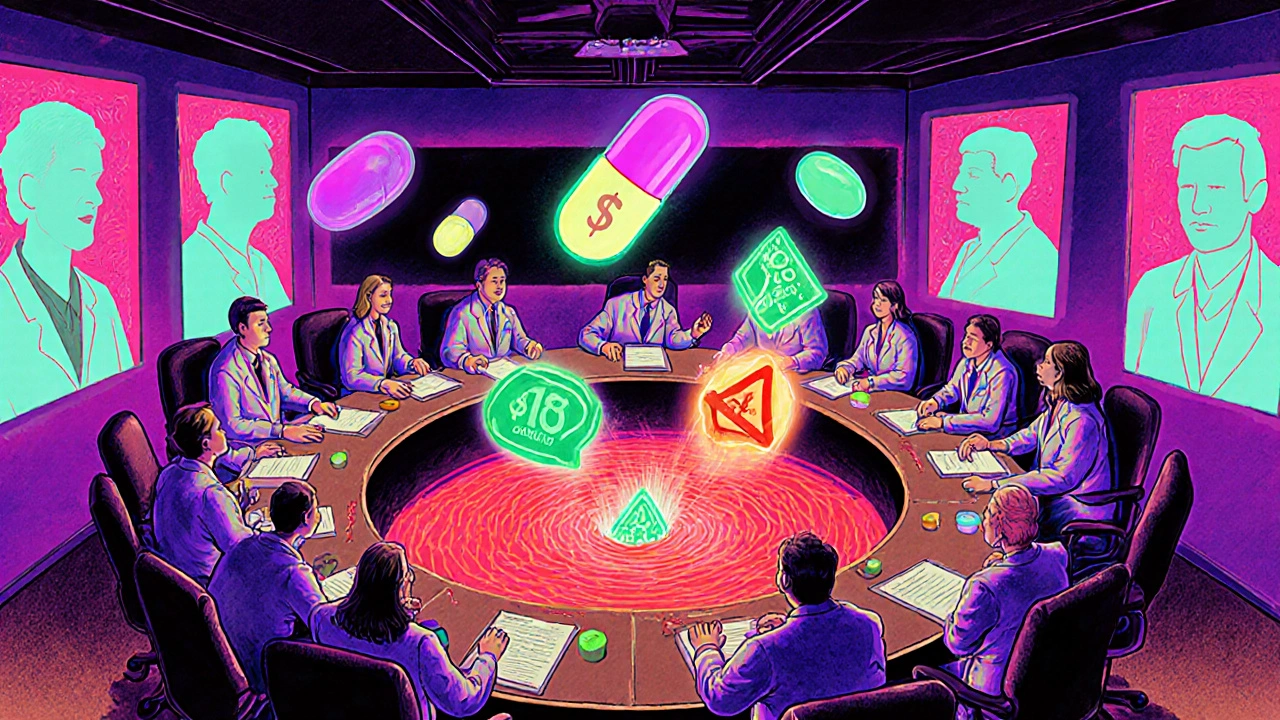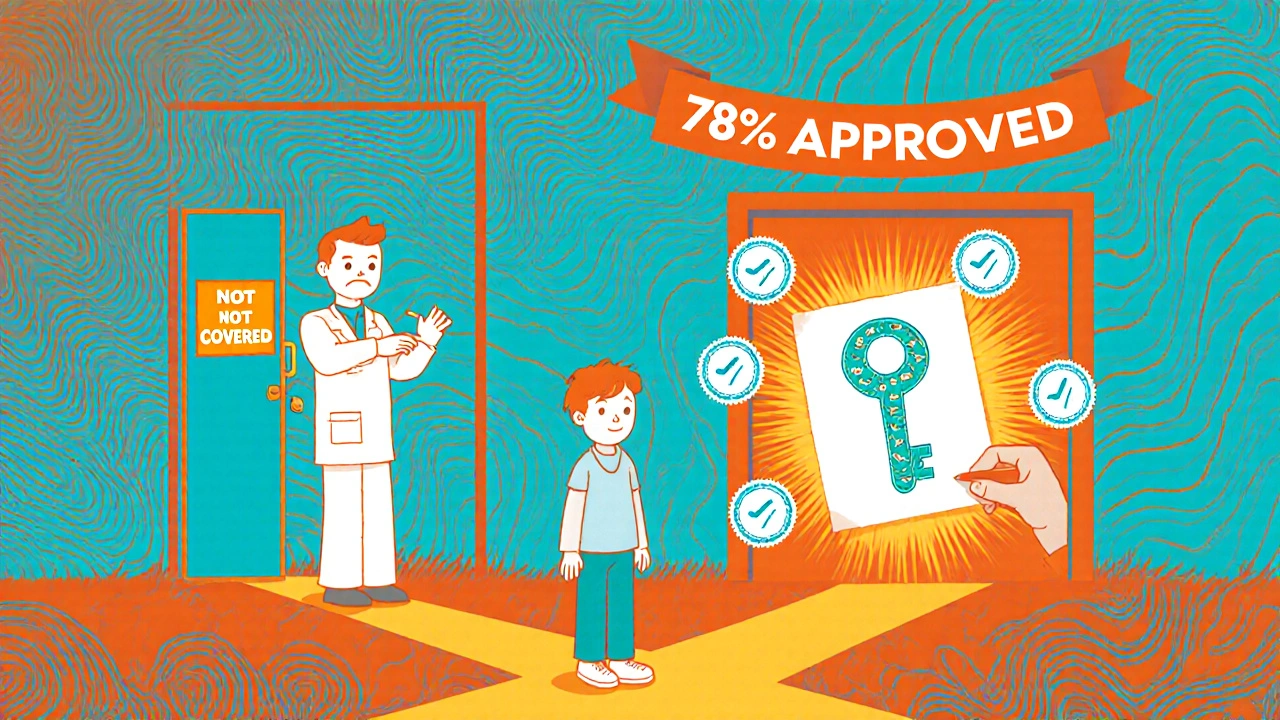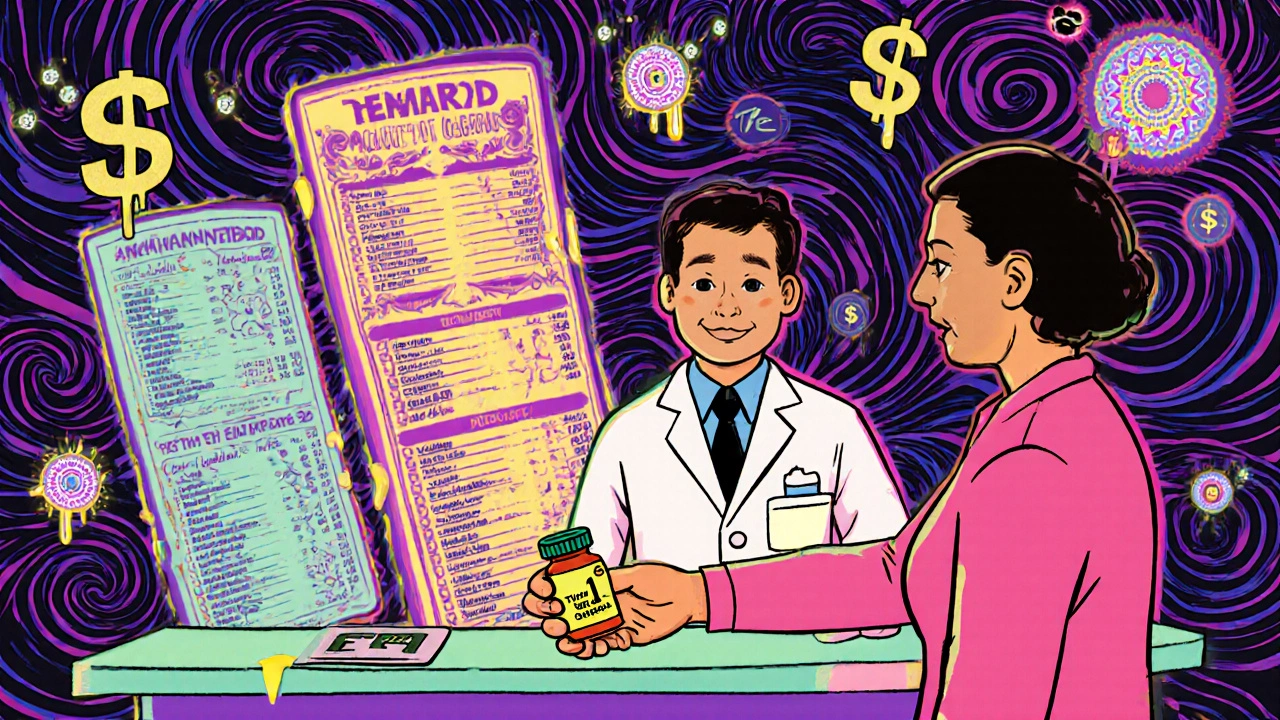When you pick up a prescription at the pharmacy and see a lower price than expected, it’s not luck. It’s because your insurer made a deliberate choice - one that affects millions of Americans every day. Insurers don’t randomly decide which generic drugs to cover. They follow a strict, data-driven system designed to save money without sacrificing care. Understanding how this works can help you get the meds you need faster and avoid surprises at the counter.
How Formularies Work
Every health plan has a list of approved drugs called a formulary. Think of it like a menu of medications your insurance will pay for. Generics are almost always at the top of that list. Why? Because they work the same as brand-name drugs but cost 80% to 85% less. The FDA requires that generics contain the exact same active ingredient, dosage, and strength as the original. They just don’t come with the marketing budget. Most plans use a tiered system. Tier 1 is where you’ll find the cheapest generics - often with a $0 to $15 copay for a 30-day supply. Tier 2 might include higher-cost generics or some brand-name drugs. Tier 3 and above are for specialty or non-preferred drugs, where you could pay $50, $100, or more. Medicare Part D plans, which cover over 50 million people, use this model too. In fact, 92% of them put all generics in Tier 1. That’s not a coincidence. It’s policy.The P&T Committee: The Real Decision-Makers
Behind every formulary is a Pharmacy & Therapeutics (P&T) committee. These are groups of doctors, pharmacists, and sometimes patients who review drugs based on three things: clinical effectiveness, safety, and cost. They don’t just look at lab studies. They dig into real-world data - how a drug performs in older adults, people with multiple conditions, or those in rural areas. If two generics treat high blood pressure equally well, but one costs $5 and the other costs $18, the cheaper one wins. That’s the rule. But it’s not just about price. If a generic has a pattern of side effects - even if it’s rare - the committee will take notice. Safety isn’t optional. The FDA’s approval is the first gate. No drug gets on a formulary unless it’s approved. But approval doesn’t mean automatic coverage. That’s where the P&T committee steps in. They’re the ones deciding whether a drug is worth including based on how it stacks up against others in its class.Why Some Generics Get Left Out
You might wonder: if generics are cheaper and FDA-approved, why wouldn’t every single one be covered? The answer is complexity. There are thousands of generic drugs on the market. Insurers can’t cover them all. They pick the ones that offer the best balance of cost and proven results. Sometimes, a generic is new. Even if it’s approved, insurers wait to see how it performs in the real world. Other times, there are multiple generics for the same drug. If three versions exist, the insurer may only cover the cheapest one - or the one with the most reliable supply chain. Drug shortages are a real problem. As of October 2023, 78% of the 372 active drug shortages in the U.S. were generics. If a drug keeps running out, insurers will drop it - even if it’s cheap - because patients need consistent access. There’s also the issue of therapeutic substitution. Many plans require you to try a generic before they’ll pay for the brand. In 78% of commercial plans, the pharmacy automatically swaps in a generic unless your doctor says no. That’s legal. But it doesn’t always go smoothly. About 31% of patients in a 2023 survey reported side effects after switching to a generic they hadn’t experienced with the brand. That’s rare, but it happens.
What You Can Do When a Drug Isn’t Covered
If your prescription isn’t on the formulary, you’re not stuck. You can file an exception request. This isn’t a complicated process - but it does require documentation. Your doctor needs to write a note saying why the generic won’t work for you. Maybe you had bad reactions. Maybe it didn’t control your condition. Maybe you’ve tried it before and it failed. Insurers have to respond within three business days. If they don’t, your request is automatically approved. For urgent cases - like if you’re running out of medication - they must respond in one day. The Patient Advocate Foundation found that 78% of people who appeal a denial eventually get coverage. That’s a high success rate, but it takes effort. Doctors spend an average of 13 hours a week just dealing with prior authorizations and formulary issues. That’s time they could spend with patients. And it’s one reason why so many people get frustrated with the system.Transparency Is Still a Problem
Here’s the uncomfortable truth: most insurers don’t tell you how they make these decisions. Only 37% of companies publicly share their full P&T committee criteria. You might know that your plan covers lisinopril but not why it doesn’t cover another generic version of the same drug. That lack of transparency makes it hard to predict what’s covered - especially if you switch plans. Some insurers, like UnitedHealthcare, score well on transparency ratings. Others, especially regional or smaller plans, are nearly impossible to understand. If you’re comparing plans during open enrollment, ask for the formulary. Don’t just assume all generics are covered the same way.
The Bigger Picture: Cost, Access, and Future Changes
The U.S. generic drug market is worth over $80 billion. Teva, Sandoz, and Mylan control nearly half of it. Insurers rely on these companies to keep prices low. But that pressure is growing. The Inflation Reduction Act caps Medicare Part D out-of-pocket costs at $2,000 per year starting in 2025. That means insurers will need to push even harder for high-volume generics to stay within budget. The FDA is also speeding things up. New rules aim to cut generic approval times from over three years to under 10 months. That could bring more options to formularies soon - especially for complex drugs like inhalers and insulins. But challenges remain. AI-driven personalized generics are coming. These aren’t the same as today’s mass-produced generics. They’re tailored to individual genetics. No one knows how insurers will cover them yet. P&T committees are already saying they’re unsure how to evaluate them.What This Means for You
If you take generics, you’re benefiting from a system designed to save money - and it’s working. Over 87% of all prescriptions filled in the U.S. are generics. That’s a win for patients and payers alike. But you need to be proactive. Know your plan’s formulary. Ask your pharmacist if there’s a preferred generic. If your drug isn’t covered, talk to your doctor about an exception. Don’t assume you’re out of luck. Most of the time, you’re not. The system isn’t perfect. But it’s built on clear rules. And once you understand them, you can use them to your advantage.Why does my insurance only cover one generic version of a drug?
Insurers pick the cheapest generic that meets safety and effectiveness standards. If multiple generics exist, they choose the one with the best price-to-performance ratio. They don’t cover every version because it’s not necessary - they’re all FDA-approved and work the same. Covering just one keeps costs down and simplifies the system for pharmacies and doctors.
Can my doctor force my insurance to cover a brand-name drug?
No, but they can request an exception. If your doctor proves that the generic doesn’t work for you - due to side effects, ineffectiveness, or medical need - your insurer must review it. They can’t automatically deny it. Many requests are approved, especially with strong documentation.
Are all generics the same quality?
Yes, by law. The FDA requires generics to have the same active ingredient, strength, dosage form, and route of administration as the brand. They must also meet the same strict manufacturing standards. Differences in fillers or coatings don’t affect how well the drug works. If you notice a change in how you feel after switching, talk to your doctor - but it’s rarely because the generic is inferior.
Why do some generics get pulled from formularies?
The most common reason is drug shortages. If a manufacturer can’t reliably supply the drug, insurers remove it to avoid patients running out. Price changes also matter - if a generic suddenly spikes in cost, insurers may switch to a cheaper alternative. Sometimes, a new, better generic enters the market and replaces the old one.
How often do insurers update their formularies?
Formularies are reviewed at least once a year, but changes can happen anytime. New generics, safety alerts, or drug shortages can trigger mid-year updates. Your plan must notify you if a drug you’re taking is being removed or moved to a higher tier. Always check your formulary before the new year starts.
Does Medicare cover all generics?
Medicare Part D plans must cover at least two drugs in every therapeutic category, and most include nearly all generics. But each plan has its own formulary. While nearly all generics are covered, the exact list varies by plan. Always check your specific plan’s formulary - don’t assume all Medicare plans are the same.

Neoma Geoghegan
November 25, 2025 AT 05:12Formularies are pure cost math. Tier 1 generics? That’s the sweet spot. No fluff, just efficacy and price. If it works and costs $5, it’s in. Simple.
Stop overcomplicating it.
Bartholemy Tuite
November 25, 2025 AT 18:50yo i had this wild thing happen last month - switched from brand lisinopril to the generic and suddenly felt like my brain was wrapped in cotton. no joke. doc said it’s the fillers, not the active ingredient, but bro… my body noticed. and now i gotta fight my insurance to get the one i used to take. they’re like ‘they’re the same!’ but my anxiety ain’t the same. why do they treat us like lab rats?
also the pharmacy staff literally laugh when you ask for the ‘other’ generic. like we’re asking for a unicorn.
Sam Jepsen
November 26, 2025 AT 08:48This is actually one of the most transparent breakdowns I’ve seen on how formularies work. Big props to the author. I work in pharma logistics and the supply chain chaos behind generics is insane. One factory in India has a power outage? Suddenly 30% of the country’s metformin vanishes. Insurers drop it overnight because they can’t guarantee access. It’s not greed - it’s damage control.
Also, P&T committees are way more rigorous than people think. They don’t just look at price. They dig into real-world outcomes. If you think it’s all about cutting costs, you’re missing half the picture.
Yvonne Franklin
November 26, 2025 AT 15:27Doctors spend 13 hours a week on prior auths? That’s criminal.
Time spent on paperwork = time not spent healing.
Fix the system, not the patient.
Melvina Zelee
November 28, 2025 AT 00:51i used to think insurance was just being cheap but this actually makes sense. like… if five generics do the same thing and one’s 3 bucks cheaper, why pay more? it’s not about denying care, it’s about not wasting money on identical stuff.
but the lack of transparency? yeah that sucks. i switched plans last year and my blood pressure med got yanked. no warning. had to call 3 times just to find out why. why can’t they just send a simple list? it’s 2025.
also… if your doc says ‘this one doesn’t work for me’ they HAVE to listen right? i feel like that’s the power move here.
ann smith
November 28, 2025 AT 23:03Thank you for this clear, thoughtful breakdown. 💙
It’s easy to feel powerless when your medication is denied - but knowing the system’s structure helps you fight smarter.
Always ask for the exception. Always. 78% success rate? That’s hope with paperwork.
And yes - check your formulary every year. Don’t wait for the surprise.
Daniel Jean-Baptiste
November 30, 2025 AT 15:40the part about drug shortages being a reason they drop generics is huge and no one talks about it
i had a friend on warfarin and they switched generics twice in 6 months because one batch kept running out
she ended up in the er because her levels got unstable
it’s not about cost anymore, it’s about reliability
and why do we let big pharma control supply like this?
maybe we need public manufacturing for essential generics
just saying
Ravi Kumar Gupta
December 1, 2025 AT 09:18AMERICA! You think this is bad? In India, we pay $0.10 for the same generic. No tier system. No prior auth. No drama. Just medicine.
Here, you need a PhD just to get your blood pressure pill.
They call it ‘healthcare’? More like a bureaucratic obstacle course with a side of greed.
And you wonder why people don’t take their meds?
It’s not the cost - it’s the humiliation.
Rahul Kanakarajan
December 3, 2025 AT 00:05so let me get this straight - you’re telling me people get mad because they can’t get the $18 generic when the $5 one works exactly the same?
what is this, a luxury car market?
if you can’t handle the $5 version, maybe you don’t need the drug at all.
stop treating medicine like a fashion choice.
also, ‘side effects after switching’? 31%? where’s your data? sounds made up.
you’re all just lazy and want the brand name because you think it’s ‘better’.
it’s not. it’s just more expensive.
Nikhil Chaurasia
December 3, 2025 AT 07:38I’ve seen this from the other side - working in a rural clinic. Patients cry when their med gets switched. Not because they’re picky. Because they’re scared.
They don’t know the science. They just know the pill that kept them alive changed shape, color, size.
And now they feel like a lab experiment.
Maybe the system is smart - but it’s not kind.
We need empathy in formularies, not just math.
Holly Schumacher
December 3, 2025 AT 23:2792% of Medicare Part D plans put all generics in Tier 1? That’s statistically impossible unless they’re lying or misreporting.
And you cite a 2023 survey about side effects after switching - but you don’t name the source. That’s not evidence, that’s clickbait.
Also, ‘AI-driven personalized generics’? That’s sci-fi. We don’t even have reliable pharmacogenomic testing in primary care yet.
You’re conflating speculation with fact. This article reads like a PR piece for Big Pharma’s cheaper generics division.
Wake up.
New Yorkers
December 5, 2025 AT 08:32you know what’s wild? the fact that we let corporations decide what medicine you get.
not your doctor.
not your body.
not your history.
but a committee in a boardroom in Minnesota who’s never met you.
and they call it ‘efficiency’.
it’s not efficiency.
it’s dehumanization dressed in spreadsheets.
we don’t need better formularies.
we need a system that trusts people.
not profit.